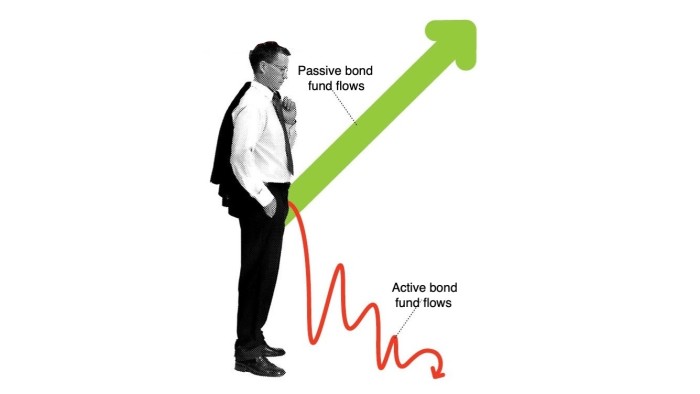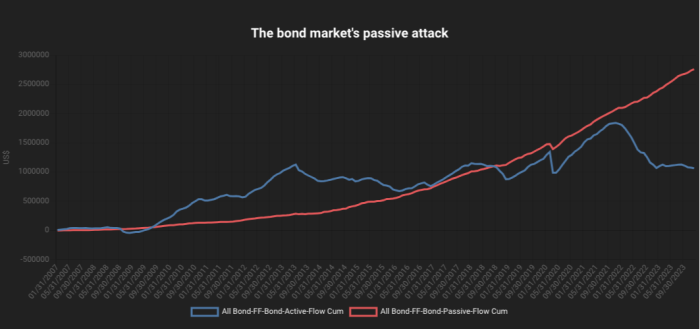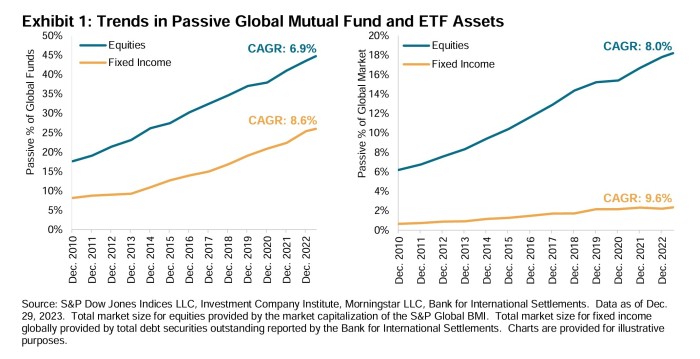The passive attack on bond markets

Simply sign up to the Sovereign bonds myFT Digest -- delivered directly to your inbox.
The first passive bond fund launched nearly four decades ago, and ever since then people have mostly made fun of the whole idea as preposterous. To be fair, there are some solid reasons for scepticism:
— The bond market is less efficient, which means more opportunities for active managers.
— Their fees are also generally lower, making cost a milder headwind.
— Bond indices are dumb; by weighting according to size it means a passive fund is tilted towards the most heavily-indebted countries and companies in the world.
— Index funds don’t buy at issuance, which means they can’t harvest the new issue premium.
— A passive approach in fixed income could mean a lot of expensive trading, eroding returns.
— etc. etc.
And yet:

Passive bond funds have seen cumulative inflows of nearly $2.8tn since the beginning of 2007. In contrast, active bond funds have only taken in a net $1tn over the same period, after taking a beating in the 2022 bear market. This is astonishing, both in scale and steadiness.
Which is why this new report from S&P Dow Jones Indices caught FT Alphaville’s eye. Although it’s primarily an equity benchmarking shop, S&PDJI’s The Hare and the Tortoise: Assessing Passive’s Potential in Bonds is fascinating.
As Tim Edwards, Anu Ganti and Agatha Malinowski point out, while passive fixed income investing started far later than passive equity investing (and is currently far less pervasive in the bond market than in the global stock market) it is actually growing considerably more quickly.

The report explores a lot of the arguments against passive bond investing — such as negative skew in the distribution of returns, bad benchmarks, practical challenges in running passive bond portfolios and data that shows active managers do (relatively) better in fixed income than they do in equities — and takes each of them apart.
We’re not going to go through all of their arguments in this post, but the reasoning seems solid throughout, so check out the full paper if you’re interested, and let us know if there’s something you think they’ve missed.
Edwards, Ganti and Malinowski argue that passive bond investing is now roughly at an inflection point similar to where equities were in 2012, when scale, breadth and acceptance meant an acceleration of inflows into passive funds.
Their emphasis below:
When there was just one index fund, it was of limited use to market participants seeking to construct portfolios of evolving allocations between global asset classes and market segments. A range of vehicles is more useful, ideally each of sufficient size and with a track record that suggests they can replicate their benchmarks. One might nowadays also hope for a range of other market participants with differing views providing liquidity to each other. Moreover, with an increasing range of low-cost indexed alternatives, the task of comparing active returns to benchmarks becomes easier. And if a passive option to track that index is also possible, the results are also more consequential. There are, in other words, benefits to scale in passive investing.
Another change from increased passive investment is that there are also network effects that can make it harder for the remaining active managers. This arises when considering where the newly deployed capital into index-based vehicles is coming from. It is likely to include some, or even many, market participants disappointed by their own prior adventures or disappointed by their appointed active managers . . . . [Other data] further suggests that the bond markets are also becoming more professionalized. The evidence points to a declining capital base among the unfortunate, the untrained or the hapless whose underperformance once provided the source of another’s market-beating returns. Flows into passive funds may indicate that a net supply of “alpha” has diminished and that, consequently, outperformance will become even harder for active managers.
Comments